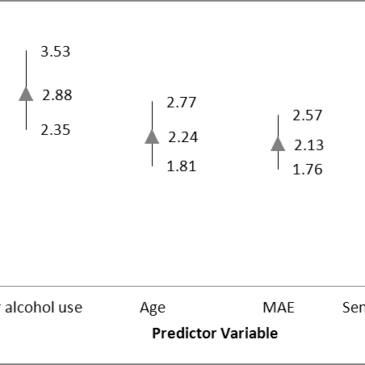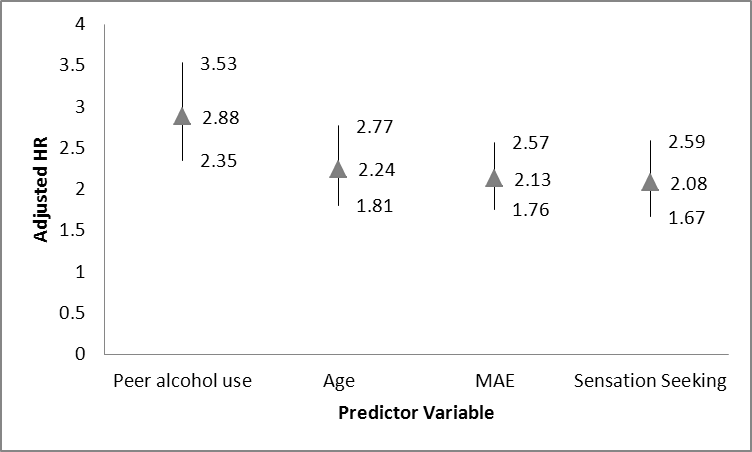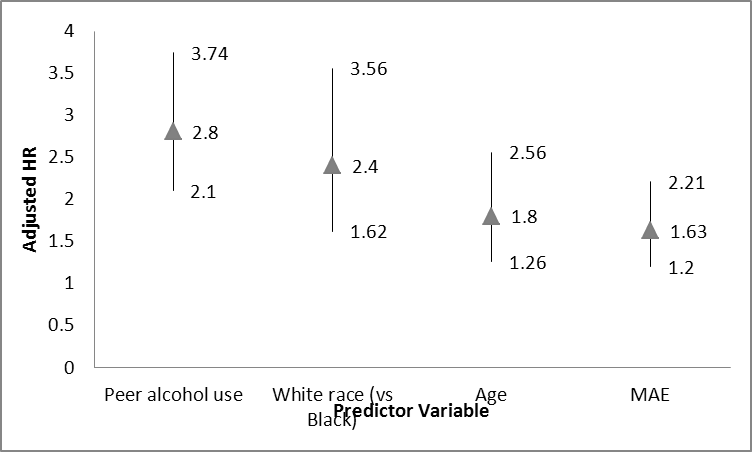Unlike the tough stance the movie industry has on smoking, the portrayal of alcohol use in movies is all but unrestricted. Moreover, during recent years alcohol use has played a role as a central plot device in movies such as The Hangover. Although research has shown that alcohol marketing (Gordon, MacKintosh, & Moodie, 2010), peer alcohol use (Ferguson & Meehan, 2011), and possession of alcohol-branded items (Fisher, Miles, Austin et al., 2007) are associated with onset of alcohol use, it is unclear how strongly movie viewing habits factor into a youth’s risk matrix for early onset drinking – especially when compared to other risk factors. This week’s BASIS examines how well- known risk factors, together with movie viewing habits, relate to teen drinking (Stoolmiller, Wills, McClure et al., 2012).
Methods
- Researchers enrolled 6,522 participants (ages 10-14) for baseline, 8-month, 16-month, and 24-month follow-up phone surveys related to alcohol use and predictors of alcohol use.[i]
- Alcohol use variables included: alcohol use onset, binge drinking, and 30 day binge drinking
- Predictor variables included: age, race, gender, parent education, family income, parent alcohol use, alcohol availability, unskilled parenting, peer alcohol use, TV viewing, movie alcohol exposure[ii], unsupervised movie watching, ownership of alcohol merchandise, sensation seeking, rebelliousness, school performance, extracurricular involvement, spending money.
- The researchers created discrete time hazard survival models for onset of first drink (i.e., progression from never-drinker to ever-drinker/ever-binge drinker) and progression to binge drinking (i.e., from ever-drinker to binge-drinker), and fitted them to the full set of predictor variables. Associations with each predictor were computed as adjusted hazard rates (AHR). Adjusted hazard rates may be interpreted like relative risks.
Results
Figure 1a. Largest Adjusted Hazard Ratios for Onset of First Drink. Adapted from Stoolmiller et. al. (2012).*
Figure 1b. Largest Adjusted Hazard Ratios for Progression to Binge Drinking. Adapted from Stoolmiller et. al. (2012).*
*The number by each marker indicates adjusted hazard rate and the values above and below represent the 95% confidence interval.
- The authors entered all variables into predictive models simultaneously and found that peer alcohol use, age, movie alcohol exposure, and sensation seeking behavior most strongly predicted an earlier onset of alcohol use (AHR = 2.88, 2.24, 2.13, 2.08 respectively).
- Peer alcohol use, White vs. Black race, age, and movie alcohol exposure also predicted progression to binge drinking (AHR = 2.80, 2.40, 1.80, 1.63 respectively).
Limitations
- The telephone surveys used for the study generally have a higher rate of attrition for minority groups.
- In addition, the age range of the sample was limited to 10 – 14 years old. Thus, special consideration is appropriate when applying the results to the general adolescent population.
- The limited scope of the movie viewing predictor should also be noted. There was no measure of the positive vs. negative portrayal of the alcohol content, nor was there any measure of the visibility of the alcohol placement.
Discussion
Of the variables tested, peer alcohol use, age, and movie alcohol exposure were all statistically significant in predicting the onset of alcohol use and the transition to binge drinking. This is consistent with another recent multivariate study (Hanewinkel, Sargent, Poelen et al., 2012).
Not surprisingly, the strongest predictor for both outcomes in this study was high peer alcohol use. Teens were almost 3 times more likely to start drinking and binge drinking when their friends also drank. Movie alcohol exposure also was a strong marker for the onset of drinking; however, it had a much smaller effect on binge drinking. Additionally, although race/ethnicity did not predict the onset of drinking, Caucasian teens were more likely to progress to binge drinking.
Even after controlling for various possible confounders, movie alcohol exposure still emerged as a strong predictor of alcohol use. This suggests that future studies should examine whether MAE rules can contribute to reducing underage drinking.
-Jed Jeng
What do you think? Please use the comment link below to provide feedback on this article.
References
Ferguson, C. J., & Meehan, D. C. (2011). With friends like these…: peer delinquency influences across age cohorts on smoking, alcohol and illegal substance use. European Psychiatry, 26(1), 6-12.
Fisher, L. B., Miles, I. W., Austin, S. B., Camargo, C. A., Jr., & Colditz, G. A. (2007). Predictors of initiation of alcohol use among US adolescents: findings from a prospective cohort study. Archives of Pediatrics & Adolescent Medicine, 161(10), 959-966.
Gordon, R., MacKintosh, A. M., & Moodie, C. (2010). The impact of alcohol marketing on youth drinking behaviour: a two-stage cohort study. Alcohol and Alcoholism, 45(5), 470-480.
Hanewinkel, R., Sargent, J. D., Poelen, E. A., Scholte, R., Florek, E., Sweeting, H., et al. (2012). Alcohol consumption in movies and adolescent binge drinking in 6 European countries. Pediatrics, 129(4), 709-720.
Stoolmiller, M., Wills, T. A., McClure, A. C., Tanski, S. E., Worth, K. A., Gerrard, M., et al. (2012). Comparing media and family predictors of alcohol use: a cohort study of US adolescents. BMJ Open, 2, e000543.
[i] (Stage 1) Random digit dial telephone survey, of 377,850 randomly generated numbers, 129,002 were valid home numbers. (Stage 2) Identification of households with age-eligible children, of the 69,516 households that completed screeners, 9,849 households had eligible children (age range 10-14). (Stage 3) Enrollment of children into the study, parental consent was obtained from 7,492 households; teen assent was given in 6,522 of those households.
[ii] Movie alcohol exposure (MAE): The researchers compiled a list of 532 movies that were popular within the 5 years preceding the start of the study (based on box office gross). Trained coders rated the movies for number of seconds of on-screen alcohol use. Researchers asked teens to indicate which movies of 50 randomly selected from the 532 they had watched. Based on their report, researchers calculated MAE for each teen by summing the total seconds of on-screen alcohol use.







Amy R Lockhert February 25, 2017
i know a 23 year old male and his 5 friends have a group text and it was called the “Hangover”
i get the vibes drinking excessively is Cool Like in the Movie.